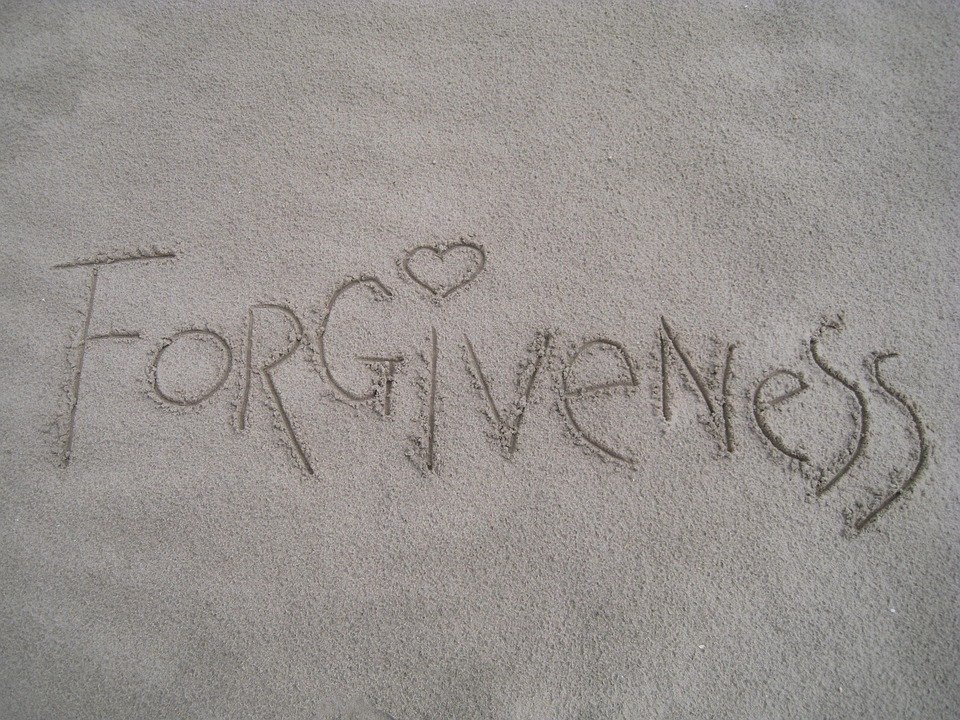Relationships are challenging. Even more so during the holidays. We are reminded of our relationships with family and friends, those with whom we get along and those with whom we don’t get along. It can be hard to navigate our relationships with those who have hurt us. Will forgiving them mean you are accepting what they did as okay? Does it mean you should allow them in your life to hurt you again? You’ve probably heard that saying, “forgive and forget.” Do you really have to forget? What does forgiveness mean and what does it look like? Does the person need to be involved in the process? What about forgiving those who have passed on whom you would never see again? Let’s talk about it!
What is forgiveness and why is it good to forgive?
Picture holding on to someone’s neck in anger. Your veins are bursting out of your neck, your face is tensed up, your hands held up in an uncomfortable position, your mind thinking of all the terrible things you want to do, your whole body is in discomfort and pain. This is what unforgiveness feels like, but all this is happening in your mind and heart, and the other person is not present.
“To forgive is to set a prisoner free and discover that the prisoner was you.” Lewis B. Smedes
Forgiveness means giving up your right to hold on to anyone’s neck. It means letting go of your desire to inflict any form of pain or revenge regardless of the pain they caused you. Sometimes we can feel like we owe it to ourselves to keep our anger. It may seem like unforgiveness is part of you upholding justice because they wronged you. You may think your unforgiveness only affects your relationship with the one person, but what it really does is make you angry and bitter. Your feelings sometimes can’t pick and choose whom they want to be angry at, so they lash out at other people too. Think about that person holding someone’s neck, it is difficult to be that angry and be a completely peaceful person at the same time.
The Mayo Clinic reports that forgiveness lowers stress, blood pressure, and physical pain. It reduces dependency on substances like alcohol and drugs. It increases spiritual and mental well-being and leads to healthier relationships.
What does forgiveness look like?
Forgiveness is a process. It is not a one and done deal because let’s face it, the feelings you have are valid and they don’t vanish once you make the choice to forgive. It takes time for healing to occur. The choice to forgive allows the healing to begin. So, where do you begin?
- Acknowledge the hurt caused. One reason why many don’t forgive is because they find it hard to say someone hurt them. If you don’t acknowledge it, then there is nothing to forgive because nothing is wrong. Acknowledging that someone hurt you means you have to feel some pain to recognize it is there. That implies that someone else has some power to affect you, many people don’t want to admit this part. But, there is no use for a power trip, you are human and as long as you are breathing anyone can affect you. Welcome to humanity! Parents or society or someone may have told you, “Ah don’t be too soft” “Africans insult each other all the time” “You know how African parents are” “Men don’t cry” “Think about all the other things they have done for you” … Whatever it is. Don’t let those distorted views prevent you from noticing that something hurt you. You are human and you feel pain!
- Confess. What do you mean? They are the ones that wronged me. True and you have a role in it too. Confessing goes along with acknowledging. When you hide the wrong that others have done to you, you essentially lie to yourself and to God. There is just a little bit of pride in there thinking that you are too big or too strong to be hurt by someone else. In some ways that is denying your humanity and the feelings that God gave you. In addition, confessing also means agreeing that you are not perfect yourself and you have wronged other people before. To effectively forgive, there’s a part of us that gets in touch with our own flaws. We recognize that there have been situations where we hurt others intentionally or unintentionally. If you can’t think of any wrong you have ever done, think about the fact that you and I have wronged God to the point where He chose to have His only son, Jesus, pay for the wrong that we did (1 John 3:5). Moreover, confession relieves us. In Psalm 32:3-5 ESV, David describes the difference between when he hadn’t confessed from when he did.
For when I kept silent, my bones wasted away
through my groaning all day long.
For day and night your hand was heavy upon me;
my strength was dried up as by the heat of summer.
I acknowledged my sin to you,
and I did not cover my iniquity;
I said, “I will confess my transgressions to the Lord,”
and you forgave the iniquity of my sin.
- Decide to forgive and do it. Let’s get something straight, forgiveness is not a feeling, it is a choice and it usually doesn’t feel good, but it is absolutely good for you as was already stated. You have to decide to forgive. It could mean saying it over and over again, “I forgive you.” It doesn’t have to be done in person. Actually, sometimes it is preferable not to be done in person when the person is still a danger to you. What is most important here is that you decide with yourself that you are forgiving this person. You can write a letter to the person and not send it, you can say a prayer of forgiveness while asking for God’s help, you can put an empty chair in front of you and visualize the person sitting there while you talk to them.
- Forgiving doesn’t mean forgetting. As I already stated, the healing after forgiving is a process. It is similar to a physical wound. Initially it hurts, then the pain goes away slowly, the wound closes up but the scar remains. You look at the scar and you can remember where you got it from but there’s no pain attached to the scar. With time the scar might even go away all together depending on how deep the wound was. Forgiveness begins this process and as time goes on, the pain of what happens dissolves and it may just become a past memory, or you may forget about it completely. Note that a painful memory of something doesn’t necessarily imply that you haven’t forgiven. Rather, there is still some healing you need from it.
- Forgive yourself. You know all the times you wish you had said or done what you know now? We can hold a lot of anger towards ourselves for the things we allowed to happen to us even if it was out of our control. You need to forgive your past self who didn’t know any better. Even if there was something you could do back then, you didn’t know at the time, just like that person didn’t know better either. Unfortunately, some people will stay that way for as long as they live and that’s on them. You on the other hand, know now what you didn’t know then. Forgive yourself!
- Acceptance. When we forgive, we begin to heal. Again, begin to heal! The healing process takes time depending on the situation. Forgiving a good friend for forgetting your birthday might take less time than finding out that your husband cheated on you. Repeated emotional neglect by a parent can be difficult to navigate from a one-time incident. Depending on the circumstance, it may require regaining trust, rethinking how to relate with someone who doesn’t see how they hurt you, and accepting that you may never have the type of relationship you want with this person. All these aspects require accepting things as they are, as they have been, and in some cases as they will be. That person may never say, “I’m sorry.” They may never relate to you differently. You need to accept that and decide how you will be different.
- Communicate what’s okay and not okay for you. This is one practical to acceptance. We have already given up our right to revenge but how do we make sure this never happens to us again? When bad things happen to us, we can sometimes create a wall. This is our way to control and protect ourselves. However, what that wall does is block the bad, but also the good from coming into our lives. A better way is to create a boundary which is simply knowing and communicating “what’s okay and not okay with me.” We cannot prevent the bad from ever happening again, but we can learn how we want to be treated. When you notice what hurt you and why it hurt you, you can let people know how you want to be treated, so they can be better at relating to you. When they don’t, you act accordingly.
- Forgiveness doesn’t mean reconciliation. Repentance is an important part of reconciliation. When someone repents, they recognize that they did something wrong and they turn from their old ways. Without repentance, reconciliation can be tough and, in some cases, impossible. It makes sense in the same way that God cannot reconcile us to Himself if we don’t repent. Therefore, I can forgive you and choose to keep my distance, if not you will continue to hurt me. It’s like me knowing that the stove is hot and repeatedly putting my hand on it. I’ll continue to get burned until I choose to stop putting my hand there. (I wrote about this in regard to sexual abuse here.) Passages in the Bible say if you keep yourself in such situations repeatedly, you become a fool because you are not learning from your mistakes.
- Surrender your will to God. This part can be difficult. Think of it this way, you are letting them off the hook and giving yourself and them to God. You can’t go back and fix it, you can’t fix them, you can’t even fix yourself, but God can. The ultimate healer is God. Choosing to forgive allows him to restore you. You talk to God and hand it over to Him. Pray for your heart and mind to be healed. And pray for this person who hurt you. You will be amazed at how prayer can transform you.
Here are some resources for more studies
- Forgiveness: Letting go of grudges and bitterness by The Mayo Clinic
- Forgiveness by Psychology Today
- What is Forgiveness and What Are the Benefits? by this Positive Psychology website
- Study the story of Joseph in the Bible in Genesis chapters 37, 39-45
- Study the story of Jacob and Esau in Genesis chapter 25, 27, 32-33. (Note Genesis 33:4)
- Some Bible passages that could be helpful are Matthew 18:15-17, Matthew 5:23-26, Hebrews 12:14, Luke 17:1-6, Matthew 6:14-15, Colossians 3:13, Romans 3:23, Ephesians 4:26.







3 Responses
Loved this article! Thanks, Dr. Amin! 🙂